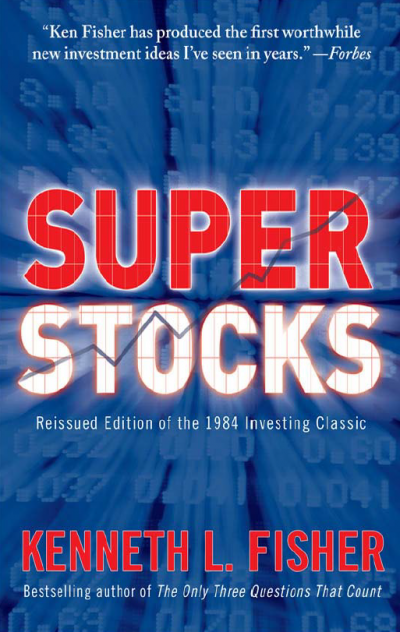Super Stocks
Super Stocks, Kenneth L. Fisher. Best seller, the only three questions that count.
Đặt in thành sách tại HoaXanh, xem sách in mẩu trong video bên dưới.
![]()
- 100,000đ
- Mã sản phẩm: SU1924
- Tình trạng: 2
PART ONE
THE ANATOMY OF A SUPER STOCK
Chapter 1
Get Rich with the “Glitch” 3
Analyzing Super Stocks—In Search of “The Perfect Glitch”
Chapter 2
What Makes the Glitch Twitch? 17
Tough Times Separate the Men from the Boys: AWarning First. They’ll
Bitch at the Glitch. “Success Has a Thousand Fathers, but Failure Is a
Bastard.” Some Companies Make It—Some Don’t.
PART TWO
VALUATION ANALYSIS
Chapter 3
Conventional Approaches to Stock Valuation—The Riddle:
Ten Times Earning’s Is too High and a Thousand Times Is
Too Low 31
The Problem: If Left Field and Right Field Don’t Work, Get Out of the
Stadium. Earnings-Based Methods: The “Underpriced, Low P/E” School.
The Growth Stock School of Thought. The Ben Graham Approach—
”Remarkable but Not Enough.” The Solution.
Chapter 4
Pricing Is Everything—Use Price Sales Ratios 39
Bulls, Bears, and Turkeys. Understanding Price Sales Ratios (PSRs). What
Does the Relationship between Price and Sales Mean? A Case in Point:
The Datapoint. A Super Stock Is a Super Company Bought at a Low PSR
Relative to the Company’s Size. What Is a Low PSR, What Is a High PSR,
and Why? Studying the Solution. Getting the Right Slant on Stocks.
Swimming Upstream as You Grow. A Fear of Heights. The Threshold of
Never-Never Land. The Economics of Going Public.
Chapter 5
Price Research Ratios—The Cost of a Good Set of Brains 61
The Problem—Landing a Whale. What is the Price Research Ratio?
Research Is Just a Commodity. Market Research Wags Technical
Research: The Solution. Rules for Using PRRs. Problems with PRRs.
Chapter 6
Applying Price Sales Ratios to Nonsuper Stocks 75
PSRs, the Broader Concept. Lessons of the Past—PSRs in the Bull Market of
the 1960s and Early 1970s. PSRs and the Great American Smokestack Stock.
Use PSRs as THE Stock Market Timing Device. Fisher’s Rules for Timing
the Stock Market. PSRs in the “Garbage Dump” of the Stock Market.
Chapter 7
Fortunes from Failures—The Myth of the 1930s 95
Through the Time Warp. IBM Not a Growth Stock? Spectacular Profits
with Low-PSR Stocks. What about All Those Great Companies?
PART THREE
FUNDAMENTAL ANALYSIS
Chapter 8
Super Companies: The Business Aspects—
Stalking Excellence 109
Basic Business Traits. Growth Orientation. Marketing Excellence:
Quanta-Ray: “Underpromise; Overperform”—Customers Are the Best
Salesmen. Is Management in Control of Marketing? How Are Sales and Service
Handled? Find the Unfair Advantage: Does the Customer Get the “Best Bang
for the Buck”? Labor Relations Are Critical. Financial Controls—Question
the Answers.
Chapter 9
Avoid Risk—Avoid Competition 127
David and the Anteaters. Avoid the Places Anteaters Hang Out. The
Japanese Zap Large Markets—Sometimes. Small (and Different) Is Beautiful.
Remember Your Teddy Roosevelt—Walk Softly but Carry a Strong Balance
Sheet. Who Stands behind the Financials? Who Has Controlling Interest?
Chapter 10
Margin Analysis—All I Really Want in Life Is an
Unfair Advantage 135
The Problem. Some Definitions. Look for Clues from the Past: Who
Kicked the Sleeping Dog? When in Doubt, Ask! From Rags to Riches.
Something Rather Unique Must Be Done. All I Really Want in Life Is
an Unfair Advantage: High Market Share Can Be an Unfair Advantage.
Relative Market Share Is More Powerful Still.
Chapter 11
Margin Analysis Continued—Formulas and Rules 149
A Forecasting Formula for Margin Analysis: Some Examples. Rules for
Margin Analysis. No One Is Perfect—You Don’t Have to Be.
PART FOUR
DYNAMICS
Chapter 12
Into Action—There’s Method to the Madness 159
Where Is the Magic Key? Opportunities Are Seldom Labeled: Scan
for Low PSRs. Scan for Money-Losing Companies. Scan for Qualitative
Assessments of Superior Companies. The Best Research Facilities Cost
Nothing to Use. Take an Important Side Step in Time. The Key to
Esoteric and Little-Known Publications. Avoid Competition from
Wall Street. Visit the Company: Getting Your Foot in the Door. Contact
Customers, Competitors, Suppliers, and Investment Professionals. It’s
Time to Reach a Conclusion.





